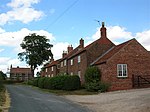Bolton, East Riding of Yorkshire
East Riding of Yorkshire geography stubsFormer civil parishes in the East Riding of YorkshireOpenDomesdayUse British English from November 2014Villages in the East Riding of Yorkshire

Bolton is a village and former civil parish, now in the parish of Fangfoss, in the East Riding of Yorkshire, England. It is situated approximately 10 miles (16 km) to the east of the city of York and 3 miles (5 km) north-west of the town of Pocklington. In 1931 the parish had a population of 130. Bolton was formerly a township in the parish of Bishop Wilton, from 1866 Bolton was a civil parish in its own right, on 1 April 1935 the parish was abolished and merged with Fangfoss, part also went to form Bishop Wilton.Bolton has an active local history society.
Excerpt from the Wikipedia article Bolton, East Riding of Yorkshire (License: CC BY-SA 3.0, Authors, Images).Bolton, East Riding of Yorkshire
Manor Green,
Geographical coordinates (GPS) Address Nearby Places Show on map
Geographical coordinates (GPS)
| Latitude | Longitude |
|---|---|
| N 53.961015 ° | E -0.824831 ° |
Address
Manor Green
Manor Green
YO41 5QS
England, United Kingdom
Open on Google Maps








